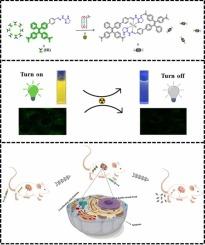四苯基乙烯衍生物修饰的N^N-双齿配体对铀的检测和体内外脱配
IF 11.3
1区 环境科学与生态学
Q1 ENGINEERING, ENVIRONMENTAL
引用次数: 0
摘要
铀一旦进入人体,就会在肾脏和股骨中积聚。其强大的化学毒性和放射性可导致严重损害,构成重大健康风险。因此,迫切需要开发能够有效探测和去除铀的低毒材料。本研究合成了一种新型的N^N双齿配体,该配体由四苯基乙烯衍生物修饰,命名为HI。这种双齿配体具有双重功能:在体外和体内都能选择性识别UO22+,并能有效促进UO22+的去除。HI对UO22+具有显著的敏感性。HI对UO22+具有较低的毒性和较好的去除率。此外,HI通过与UO22+螯合来减轻氧化应激和DNA损伤,从而显著降低UO22+暴露引起的高细胞凋亡率。值得注意的是,预防性注射HI可使小鼠肾脏和股骨中UO22+的含量分别减少65.5%和39.8%。鉴于其具有良好的性能,HI成为检测和修复UO22+污染的潜在候选材料,为解决铀污染带来的健康挑战提供了新的途径。本文章由计算机程序翻译,如有差异,请以英文原文为准。

A N^N-bidentate ligand modified with tetraphenylethylene derivative for uranium detection and decorporation in vitro and in vivo
Uranium, once introduced into the human body, tends to accumulate in the kidneys and femurs. Its potent chemical toxicity and radioactivity can lead to severe damage, posing significant health risks. Consequently, there is an urgent need to develop low-toxicity materials capable of effectively detecting and removing uranium. In this study, a novel N^N-bidentate ligand modified with a tetraphenylethylene derivative, designated as HI, was synthesized. This bidentate ligand demonstrates dual functionality: it can selectively recognize UO22 + both in vitro and in vivo, and it effectively facilitates the removal of UO22+. HI exhibits remarkable sensitivity for UO22+. Compared to a commercial decorporation agent diethylenetriamine pentaacetic acid (DTPA), HI shows lower toxicity and superior removal efficiency for UO22+. Furthermore, HI mitigates oxidative stress and DNA damage by chelating with UO22+, thereby significantly reducing the high rates of cell apoptosis induced by UO22+ exposure. Notably, prophylactic administration of HI resulted in the removal of 65.5 % and 39.8 % of UO22+ from the kidneys and femurs of mice, respectively. Given its promising properties, HI emerges as a potential candidate for both the detection and remediation of UO22+ pollution, offering a new avenue for addressing the health challenges posed by contamination of uranium.
求助全文
通过发布文献求助,成功后即可免费获取论文全文。
去求助
来源期刊

Journal of Hazardous Materials
工程技术-工程:环境
CiteScore
25.40
自引率
5.90%
发文量
3059
审稿时长
58 days
期刊介绍:
The Journal of Hazardous Materials serves as a global platform for promoting cutting-edge research in the field of Environmental Science and Engineering. Our publication features a wide range of articles, including full-length research papers, review articles, and perspectives, with the aim of enhancing our understanding of the dangers and risks associated with various materials concerning public health and the environment. It is important to note that the term "environmental contaminants" refers specifically to substances that pose hazardous effects through contamination, while excluding those that do not have such impacts on the environment or human health. Moreover, we emphasize the distinction between wastes and hazardous materials in order to provide further clarity on the scope of the journal. We have a keen interest in exploring specific compounds and microbial agents that have adverse effects on the environment.
 求助内容:
求助内容: 应助结果提醒方式:
应助结果提醒方式:


